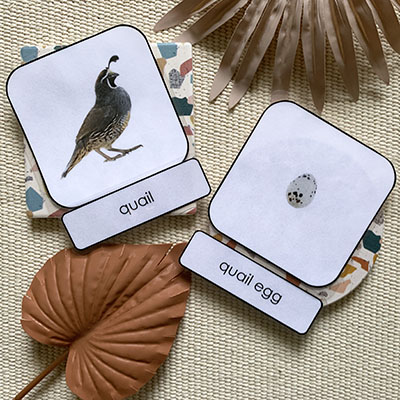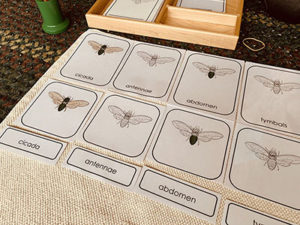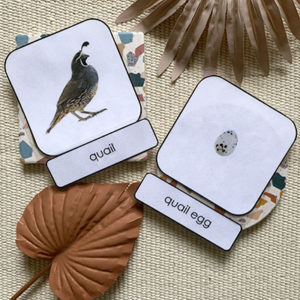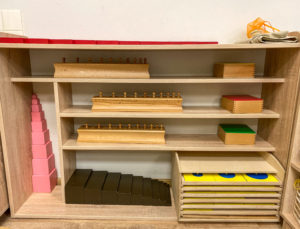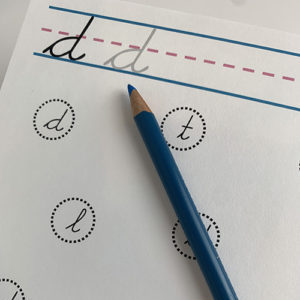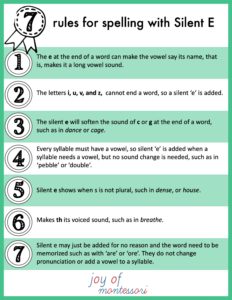Classroom Ideas for Spring
Spring is a natural time of energy and renewal. Even though the school year may soon be drawing to a close, I find spring the perfect time to spruce up the classroom with new activities, especially those related to the season and the new things children will encounter outdoors. Personally, I love gardening and spending time outside and I try to share that love with my students. So much so, I wrote a song about bugs (because believe it or not, they are hard to find! LOL)
Children in the 3-6 age range are often in a sensitive period for order which includes things like grouping similar items together, comparing, contrasting, grading, and classifying. Montessori nomenclature cards featuring their favorite (or even unfamiliar) bugs, plants, and animals can be a perfect fit. Read on for some ways I like to incorporate them in my teaching as well as other ideas for spring!
Insect Activities
Speaking of bugs…I find most kids are fascinated by them – or they might be a bit squeamish. You don’t have to be a “bug person” to teach kids about all the benefits of the insects we encounter and how vital they are in the food chain. It can help ease any discomfort kids have when they know that bugs are our friends. (I like to remind people who are afraid of spiders that it’s the spiders that keep away a lot more of the other bugs that could be lurking around…) The song about bugs I wrote comes with clip art of the insects and flowers they love, coloring sheets, and a game you can play!
When the Brood X Cicadas were arriving in our area, I used the opportunity to create a cicada activity and educate the children about these harmless bugs and the fascinating story of how the live underground for 17 years! Some children find the cicadas to be scary, but that can sometimes be due to a lack of familiarity. Instead, my students really fell in love with cicadas!
Baby Animals and Life Cycles


In spring we also talk about baby animals which is another favorite topic for kids. Arrange a visit to a local farm if possible, and children may see various stages of the life cycle in real life. I created nomenclature cards of birds and their eggs that the kids have been loving lately. These birds and eggs nomenclature cards allows children to identify eggs, order them by size, or by the type of bird that lays them.
Another idea is to ask around your local community or on a Buy Nothing Group to see if someone knows where tadpoles can be found. Last year someone had thousands of them in their pool cover and wanted to rescue as many as possible, so we brought a tank into the classroom and studied the frog life cycle in real time comparing them to figurines and learning with nomenclature cards.
Outdoor Skills and Safety
If you are a classroom teacher taking your students outdoors, it is important that you communicate clearly with parents ahead of time about the appropriate gear their children need. Do you plan to be outside in sun for long periods of time? Will the kids get wet or muddy? Should they have a change of clothes on hand? Make sure you know your school’s policies about things like sunscreen and bug spray application. Additionally, if there is an insect or animal local to your area that can be harmful, make sure you educate the parents about how that will be handled and teach the children about ways to stay safe outdoors.

Create an Outdoor Learning Space
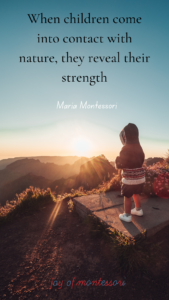 In addition to the activities you have inside on the shelves, you may want to take your spring education to the next level by creating an outdoor learning space. If so I highly recommend you head over to my friend Tina’s blog at Teach the TK Way and you will find a wealth of resources for outdoor education. For example you could start with a meaningful and doable class project such as creating a butterfly garden. Even simply heading outdoors for story time could be a wonderful start to an outdoor literacy routine.
In addition to the activities you have inside on the shelves, you may want to take your spring education to the next level by creating an outdoor learning space. If so I highly recommend you head over to my friend Tina’s blog at Teach the TK Way and you will find a wealth of resources for outdoor education. For example you could start with a meaningful and doable class project such as creating a butterfly garden. Even simply heading outdoors for story time could be a wonderful start to an outdoor literacy routine.
Many schools have outdoor space that can be used for gardens. I recently learned that the renowned chef Alice Waters of Chez Panisse is also a trained Montessori teacher! She created a program called the Edible Schoolyard with lesson plans for all ages as well as a gardening and cooking curriculum.

